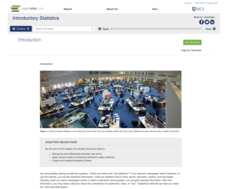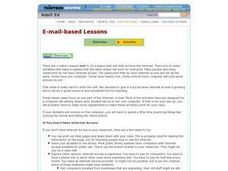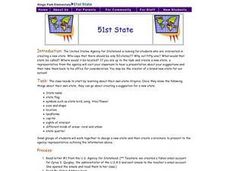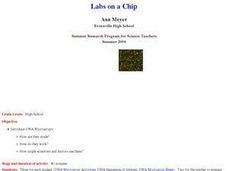Virginia Department of Education
Partial Pressure
At some point, everyone has been under pressure—even Dalton! Explore Dalton's law of partial pressures with young chemists as they measure the volume of air extracted from a sample compared to its original volume. Class members perform...
Teach Engineering
Slinkies as Solenoids
What does an MRI machine have to do with a slinky? This activity challenges learners to run a current through a slinky and use a magnetic field sensor to measure the magnetic field. Groups then change the length of the slinky to see the...
Teach Engineering
Inside the DNA
Get your class to take a closer look at DNA. Pupils conduct research to determine the methods used by scientists to analyze the molecular structure of DNA. The class members investigate different types of molecular imaging along with gel...
Chicago Botanic Garden
Greenhouse Gas Emissions – Natural and Human Causes
Part three in the series of seven has pupils discussing the different greenhouses gases, learning about the carbon cycle, and then watching a short video about the carbon cycle. Based on their knowledge, individuals complete a greenhouse...
Chicago Botanic Garden
Climate Change Around the World
It is unknown if cloud cover increases in response to carbon dioxide levels changing, helping climate change slow down, or if cloud cover decreases, allowing Earth to warm faster. Part four in the series of five lessons has classes...
Rice University
Introductory Statistics
Statistically speaking, the content covers several grades. Featuring all of the statistics typically covered in a college-level Statistics course, the expansive content spans from sixth grade on up to high school. Material comes from a...
Curated OER
E-mail-based Lessons
Students practice using computers. They use the Internet to practice surfing the web and finding information. They also practice writing emails and journal entries.
Curated OER
Transforming Fairy Tales: Transforming Characters
Students practice using ClipArt style programs on their computers. In this digital imaging lesson plan, students utilize an image computer program to copy images of characters using the lasso tool and pasting them into another...
Curated OER
Transforming Fairy Tales - Lesson 5: Creating a character template
Second graders create a character template for their fairy tale. For this character lesson, 2nd graders using the Paint program on the computer to create their character. They use this character throughout their pictures without needing...
Curated OER
Numbers Activity
Students practice identifying quantities of items and materials using numbers. In this counting lesson, students read The Gummi Bear Counting Book by Lindley Boegehold, and utilize a bag of gummy bears as a counting tool. Students...
Curated OER
If I Were A Raindrop!
Students review the water cycle. In this water cycle lesson, students review the different stages of the water cycle. Students use the computer program Kid Pix Weather to help demonstrate understanding.
Curated OER
The Nesting Habits of Folders
Students create an organized web of nested grade level folers. Within each grade level folder, they create a Language Arts/Social Studies folder and a Math/Science folder. All folders be color coded.
Curated OER
About The Author
Fourth graders practice using basic word processing skills to create a document that includes graphics. The teacher uses a LCD projector to provide support during the lesson. They practice using Word Art to create their own graphics that...
Curated OER
51st State
Students, in small groups, design a new state and create a brochure to present to an agency representative outlining the given information in the lesson. Students use templates in the compute lab to write sentences they have created...
Curated OER
Determining the Relationship Between pH and Hydrogen Ions with Microcomputer Based Lab (MBL) and/or Calculator Based Lab (CBL) Equipment
High schoolers find the relationship between the variables based on experimental data. They determine mathematical relationship between pH and the amount of hydrogen Ions in solution.
Curated OER
Parabola (Lab Version)
Students develop definition for parabola, explain relationship between properties of the graph of a parabola and its equation, explain how the equation of a parabola can be written in different forms, and solve problems that relate the...
Curated OER
Points in the Complex Plane -- Lab
Students review the lecture portion of this lesson. Individually, they graph various points on a complex plane and identify conjugates based on their location on the graphs. They complete a worksheet and review their answers to end the...
Curated OER
Computer Science: Pendulum
Learners investigate the basic properties of pendulums as a function of spreadsheets. Working in groups, they measure the period for a pendulum at six different lengths and record the results. They prepare a file using Microsoft Excel...
Curated OER
Labs on A Chip
Young scholars are introduced to DNA microarrays. They discuss how scientists and doctors use them and how they work. They complete a worksheet and discuss their findings.
Curated OER
Investigation of Hooke's Law Lab
Learners determine the spring constant by conducting an investigation. In this physics lesson plan, students collect data and create a graph of force vs. displacement. They compare the results of two different methods to find spring...
Curated OER
Ballistic Pendulum Lab
Students determine the muzzle velocity of projectile launcher. In this physics lesson, students compare the pendulum method and kinematic method in calculating the initial velocity. They analyze data and discuss results in class.
Curated OER
Robot Turning Lab
Students design a robot that can turn 90 degrees. In this robotics lesson, students explain the applications of their invention. They present their design in class.
Curated OER
Independent Learning Tech Station
Middle schoolers develop competencies in responsible and collaborative learning. Computer software and manipulatives may be used at this station to aid in independent learning.
Curated OER
Function Junction
Middle schoolers identify the internal and external components of computers, robots and fan. In this physics lesson, students draw a circuit diagram of their electronic components. They create a battery tester in the lab.

























